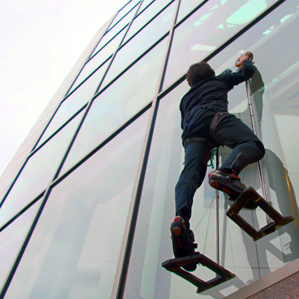Gecko-inspired adhesives can help humans climb and may provide a better grip for robotic arms in factories and in space.

A graduate student climbs using the gecko grippers.
Forget Spider-man, and meet Geckoman. Researchers at Stanford University have created a gecko-inspired human climbing system that allowed a grad student to scale a glass wall using two hand-sized sticky pads.
The researchers, led by engineer Mark Cutkosky, also hope to use the adhesives in manufacturing equipment, making grippers for manipulating huge solar panels, displays, and other objects without the need for suction power or chemical glues. The team is also working with NASA’s Jet Propulsion Laboratory to adapt the adhesive for use by robots.
Gecko toes are incredibly sticky because they are covered with groups of long, thin spatula-shaped structures called setae that increase surface area and amplify weak electrical attractions between the toes and a surface. Gecko feet stick well but are readily released when the animal shifts its weight; and of course, they can stick again and again, unlike most man-made adhesive tapes.
Researchers have made various artificial adhesives that work the same way, using clusters of carbon nanotubes or microscale wedges of molded rubber to mimic the high surface area of the setae on gecko feet. But these mechanisms have only worked well for small weights.
Carrying larger weights requires materials with larger surface areas. Using previous materials, a 70 kilogram human would require gecko-foot-like pads 10 times larger than a normal human hand in order to scale a wall. “Scaling gecko adhesion is a challenge,” says Cutkosky.
This summer, the United States Defense Advanced Research Projects Agency (DARPA)announced that its Z-Man program had, for the first time, made a gecko-adhesive-based climbing system that enabled a person to scale a wall. Although DARPA didn’t provide details on how this was accomplished, the Stanford group, which participated in the Z-Man work, has made a similar demonstration using its own adhesive system. The work is described in research published today in the Journal of the Royal Society Interface.
To make the climbing system, the researchers started with an existing adhesive based on molded microwedges made from a polymer material called PDMS. They attached tiles of this material to a flat, hexagonal, hand-sized gripper. Each gripper was backed with a spring that distributed weight across the pad, and absorbed some of the force involved in climbing. To make climbing easier, the researchers also linked the grippers to platform for a person’s feet, thereby transferring the work of climbing to the legs.
Jeffrey Karp, a bioengineer at Brigham and Women’s Hospital in Boston, notes that the test situation involved a very smooth, clean, flat surface. Karp, who cofounded a company called Gecko Biomedical to commercialize a bioinspired surgical adhesive, says the Stanford researchers will need to show that their system works in less ideal environments. In the real world, a climbing system is liable to be exposed to humidity, rain, pollen, dust, and other contaminants, he notes.
The Stanford group hopes to test the adhesive in especially extreme conditions. This month they tested it in a zero-gravity airplane with NASA and found that it still worked.
The above story is based on materials by MIT technology review.
Note: Materials may be edited for content and length. For further information, please contact the source cited above.
Copyright © 2024 International Society of Bionic Engineering All Rights Reserved
吉ICP备11002416号-1









